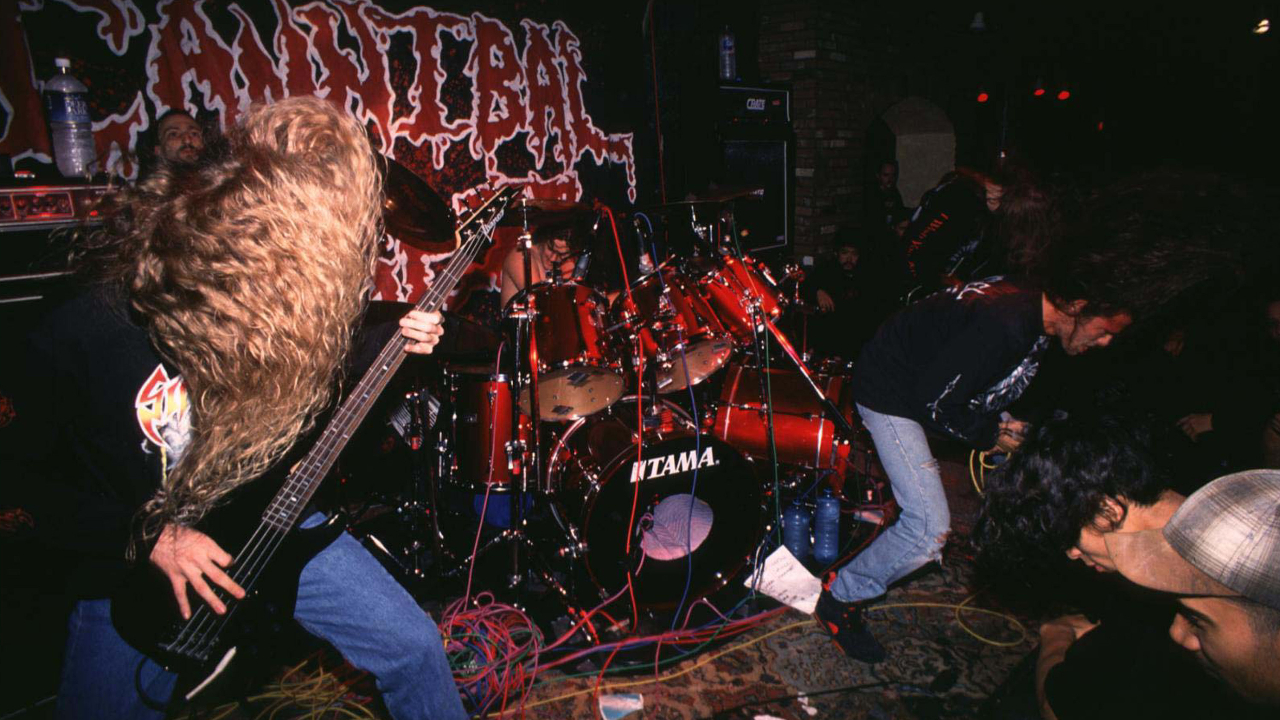Introducing Zeal & Ardor, black metal's brand new superstar
Zeal & Ardor’s soulful, slave music/extreme metal mash-up has set the underground alight. But is creator Manuel Gagneux ready to face the wrath of the elitists?

When musician Manuel Gagneux went onto the website 4chan and asked for genre mash-up ideas, one immediately jumped out: ‘n*gger music and black metal’.
“It’s a disgusting place and they just want to get a rise out of you,” he says today. “Even if they don’t know they’re dealing with a dark-skinned person, as soon as you react in an aggravated manner, they’ve basically won.”
Rising above the racist bullshit, our protagonist logged off with an idea burrowing into his brain: let’s fiddle with the status quo. Let’s challenge the norm. Let’s combine some harsh, icy black metal riffs with African-American slave spirituals and inject them with dashes of electronica and melodic death metal. Resulting album Devil Is Fine clocks in just shy of 25 minutes, but it’s an accomplished, fully realised statement that’s already caused a stir in the underground.
“It’s so eclectic and all over the fucking place,” he laughs down the phone, addressing his Beelzebubian banquet of genres.
anuel grew up in Basel, Switzerland, as the son of a white Swiss father and a black American mother. He and his three siblings were raised on a pick’n’mix of spiritual ideals, but none of them stuck. “Our parents introduced us to a lot of religions, basically letting us sample them and figure out if we were into it or not,” he nonchalantly explains. “Turns out it’s not my cup of tea!”
Meanwhile, his introduction to metal came from perusing record store shelves and picking the most badass sleeves imaginable. Fear Factory, Clawfinger and particularly Iron Maiden’s Piece Of Mind made early impressions. Maiden became thrash and death metal. That became black metal. Burzum. The nasty shit. His live music education came from the slew of weird post- rock bands that performed in local squats, with bigger acts rolling through Pratteln’s nearby Z7 venue every now and then.
Filled with a desire to concentrate on being a full-time musician, he moved to New York in 2012, aged 22. Rather than spending a year, like, finding himself and busking at the weekends, he committed to the cause, isolating himself from friends and family to force himself to produce songs. “I’m not earning anything, but it’s something I really want to do well, and that’s priority number one – not eating or going out,” he says.
Sign up below to get the latest from Metal Hammer, plus exclusive special offers, direct to your inbox!
Having already ventured into dreamy electro-pop with his other musical alias, Birdmask, he took to the anonymous, insidious website 4chan to gather new ideas for what would eventually become Zeal & Ardor. The aim was to ask randomers for two disparate genres, then mash said styles together in 30 minutes. In response, he was given ‘bossa nova doom’, ‘Nashville power electronica’ and, distastefully, the aforementioned ‘n*gger music and black metal’.

Upon its original release, Devil Is Fine was criticised for sampling slaves’ chain gang chants, but this isn’t the case: it’s all Manuel reciting made-up hymns in the key of Hell. On Children’s Summon, he’s literally namechecking demons [see Waking The Demon, page 60]. For research, he spent countless hours listening to recordings by ethnomusicologist and folklorist Alan Lomax and his father John. They documented thousands of work songs, spirituals and prison chants throughout the 20th century, ensuring the plights, hopes, dreams and fears of those enslaved could never be forgotten.
“It affected me a great deal emotionally,” he says. “It’s such a strong, sad, and even euphoric kind of music. It wouldn’t have been attractive to me at all if it didn’t have this cathartic weight to it.”
It’s a striking subject matter to hook an extreme metal record on. He’s created an imaginary world where slaves have rejected the Christianity of their masters and succumbed to Satan, running in ideological tandem with the early, church-burning Norwegian black metal scene. The cover of Devil Is Fine even features Civil War hero Robert Smalls – a slave who commandeered a Confederate ship and sailed its crew to freedom, before becoming a politician – ensconced in a Luciferian sigil. But by mixing the music and imagery of people who were horrifically oppressed with music and imagery from a genre that, at its ugliest, has celebrated white nationalism, Manuel is making a controversial statement. Is it really OK to do this?
- Zeal & Ardor: The most unique band to grace the underground this year
- Zeal & Ardor - Devil Is Fine album review
- Zeal & Ardor are channelling black metal and the American slave trade
- The 10 essential post-black metal albums
“It’s interesting to have that juxtaposition,” he ripostes. “That was one of the main motivations.” But surely you can see why it might piss people off? Varg Vikernes, Burzum’s mastermind, is a renowned white supremacist! “Varg can be such a dick, but I still like his music and I don’t think that changes anything about it. I think it’s a very important thing to separate the art and the artist.”
And there sits another quandary: Manuel is mixed-race. Surely he couldn’t get away with making this music if he was, say, a white Norwegian dude. “In a perfect world, it wouldn’t have mattered,” he explains. “I mean, if I were a white Norwegian dude, I’d be appropriating ‘black’ music, which, to some, would be evil. But here I am, this black guy, appropriating ‘white’ music, and nobody’s really pissed off about that! It’s a strange hypothetical double-standard.”
Has anyone criticised you for doing it?
“I can’t name names, but a certain BBC Radio 1 DJ took religious offence and elected not to play it!” he laughs. “You can’t restrict yourself ethically when you make art, to a certain degree. [As long as] nobody’s actively being hurt. If you’re gonna slaughter a baby onstage just to be cool or whatever, that might pose questions! You can take offence, but that’s something you do. You don’t give offence. That’s a shitty quote, but you know what I’m trying to say!”
Manuel never sounds riled-up or defensive. He’s aware of the parameters in which he’s working, and the racist ideologies and closed-minded views that used to come part- and-parcel with the darker corners of black metal culture. But the scene is changing. Cross-genre pollination is now commonplace. It doesn’t all sound like it was recorded in a sparrow’s arse.
“Black metal used to be the most extreme music known to man,” he reflects. “Now it’s almost classical – it’s been around for over 20 years, so it’s only natural to want to evolve it into other extremities. I can see a shift in the black metal scene, too, with this whole synth-wave scene going crazy. It’s going with the same theme as 80s synthesizer music!”
The shift is real. Manuel has already been in contact with James Kent from fellow one-man band Perturbator – basically the music from videogame TimeSplitters worshipping Satan five times a day – for possible remix swapsies, and before he’d done his first tour, he found himself booked to play the esteemed Roadburn Festival. He’s set to roll out further songs there and at his upcoming European shows, which will feature a full band, an altar and, er, a branding iron shaped in the Zeal & Ardor sigil. “I’ve practised branding on objects but not on living things – I have a strange feeling it’ll stay that way for a while!” he exclaims. Again, the set-up sounds black metal to the core, but a branding iron being swung about to a soundtrack of slave chants? A bit touchy.
“I could see people thinking that,” he admits, still not fazed. “The picture I’ve painted is disconcerting, and for the sake of congruency that has to extend to the visuals. This hasn’t happened to anyone who is alive right now. This is history. But even if it just makes people everything! He teaches philosophy and science – things I definitely appreciate!”
Devil Is Fine is out now via MVKA. Zeal & Ardor play London’s Underworld on April 20 and Roadburn Festival on April 21
Waking the demon
Uncovering the occult scriptures Manuel used to craft his chants
What demonic research did you delve into?
“It was mostly the Ars Goetia. It’s a part of The Lesser Key Of Solomon [a directory of demons compiled in the mid-17th century]. It’s actually a pretty straightforward guide to invocations [summoning entities and talking to them]. The version I have has some additional material by Aleister Crowley, further explaining the elements of ceremonies. I learned the Hebrew alphabet to dig deeper into it.”
Did you use any other books for research?
“There’s also elements of The Book Of Abramelin [another, more demanding system of magic]. It’s what one would use to summon the big bads: Belial, Satan, Lucifer and Leviathan. It’s something Aleister Crowley attempted and failed, since the ritual takes six months and requires total concentration and abstinence. Incidentally, it’s where the word ‘abracadabra’ came from.”
Which demons were you most drawn to?
“Paimon is the most relevant to me. He brings secrets and knowledge, has an army of musicians and can enslave people at will. He’d be the most fitting to the project. Murmur is a badass. He appears as a warrior on a griffin and can make you talk to the dead. Before him, there are two ministers sounding trumpets – a fanfare wherever he goes. I’ve another book where he’s painted as a sort of bird. And Buer’s got this lion head with stag legs and will share the cosmic secrets of

Alec is a longtime contributor with first-class BA Honours in English with Creative Writing, and has worked for Metal Hammer since 2014. Over the years, he's written for Noisey, Stereoboard, uDiscoverMusic, and the good ship Hammer, interviewing major bands like Slipknot, Rammstein, and Tenacious D (plus some black metal bands your cool uncle might know). He's read Ulysses thrice, and it got worse each time.


